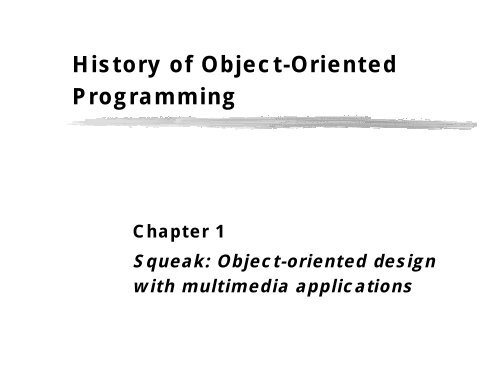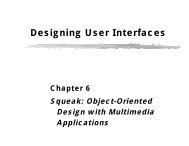History of Object-Oriented Programming
History of Object-Oriented Programming
History of Object-Oriented Programming
Create successful ePaper yourself
Turn your PDF publications into a flip-book with our unique Google optimized e-Paper software.
<strong>History</strong> <strong>of</strong> <strong>Object</strong>-<strong>Oriented</strong><br />
<strong>Programming</strong><br />
Chapter 1<br />
Squeak: <strong>Object</strong>-oriented design<br />
with multimedia applications
Start <strong>of</strong> the Story: Late 60's and Early 70's<br />
❚ Windows are made <strong>of</strong> glass, mice are<br />
undesirable rodents<br />
❚ Good programming = Structured programming<br />
❙ Verb-oriented<br />
9/19/00 Copyright 2000, Mark Guzdial 2
Structured <strong>Programming</strong><br />
❚ Define tasks to be performed<br />
❚ Break tasks into smaller and smaller pieces<br />
❙ Until you reach an implementable size<br />
❚ Define the data structures to be manipulated<br />
❚ Design how functions interact<br />
❙ What's the input<br />
❙ What's the output<br />
❚ Group functions into components ("units" or<br />
"classes")<br />
❚ Write the code<br />
9/19/00 Copyright 2000, Mark Guzdial 3
<strong>Object</strong>-oriented programming<br />
❚ First goal: Model the objects <strong>of</strong> the world<br />
❙ Noun-oriented<br />
❙ Focus on the domain <strong>of</strong> the program<br />
❚ Phases<br />
❙ <strong>Object</strong>-oriented analysis: Understand the domain<br />
❘ Define an object-based model <strong>of</strong> it<br />
❙ <strong>Object</strong>-oriented design: Define an implementation<br />
❘ Design the solution<br />
❙ <strong>Object</strong>-oriented programming: Build it<br />
9/19/00 Copyright 2000, Mark Guzdial 4
How’d we get from there to<br />
here?<br />
❚ How did we move from structured to objectoriented?<br />
❙ Key ideas<br />
❘<br />
❘<br />
Master-drawings in Sketchpad<br />
Simulation “objects” in Simula<br />
❙ Alan Kay and a desire to make s<strong>of</strong>tware better<br />
❘<br />
More robust, more maintainable, more scalable<br />
9/19/00 Copyright 2000, Mark Guzdial 5
Birth <strong>of</strong> <strong>Object</strong>s, 1 <strong>of</strong> 2<br />
❚ Ivan Sutherland's Sketchpad, 1963<br />
9/19/00 Copyright 2000, Mark Guzdial 6
Sketchpad<br />
❚ First object-oriented drawing program<br />
❚ Master and instance drawings<br />
❙ Draw a house<br />
❙ Make two instances<br />
❙ Add a chimney to the master<br />
❙ Po<strong>of</strong>! The instances grow a chimney<br />
❚ Other interesting features<br />
❙ 1/3 Mile Square Canvas<br />
❙ Invention <strong>of</strong> “rubber band” lines<br />
❙ Simple animations<br />
9/19/00 Copyright 2000, Mark Guzdial 7
Birth <strong>of</strong> <strong>Object</strong>s, 2 <strong>of</strong> 2<br />
❚ Simula<br />
❙ Simulation programming language from Norway,<br />
1966<br />
❙ Define an activity which can be instantiated as<br />
processes<br />
❙ Each process has it own data and behavior<br />
❘<br />
In real world, objects don't mess with each others' internals<br />
directly<br />
❙ (Simulated) Multi-processing<br />
❘<br />
No Universal Scheduler in the Real World<br />
9/19/00 Copyright 2000, Mark Guzdial 8
Alan Kay<br />
❚ U. Utah PhD student in 1966<br />
❙ Read Sketchpad, Ported Simula<br />
❚ Saw “objects” as the future <strong>of</strong> computer science<br />
❚ His dissertation: Flex, an object-oriented<br />
personal computer<br />
❙ A personal computer was a radical idea then<br />
9/19/00 Copyright 2000, Mark Guzdial 9
Kay’s Insights<br />
❚ “Computer” as collection <strong>of</strong> Networked<br />
Computers<br />
❚ All s<strong>of</strong>tware is simulating the real world<br />
❚ Biology as model for objects<br />
❙ Bacterium has 120M <strong>of</strong> info, 1/500th <strong>of</strong> a Cell, and<br />
we have 10^13 <strong>of</strong> these in us<br />
❙ What man-made things can scale like that?<br />
❘<br />
❘<br />
Stick a million dog houses together to get the World Trade<br />
Center?<br />
Internet does, but how can we make that the norm?<br />
9/19/00 Copyright 2000, Mark Guzdial 10
Birth <strong>of</strong> <strong>Object</strong>s<br />
❚ <strong>Object</strong>s as models <strong>of</strong> real world entities<br />
❚ <strong>Object</strong>s as Cells<br />
❙ Independent, indivisible, interacting -- in standard ways<br />
❚ Scales well<br />
❙ Complexity: Distributed responsibility<br />
❙ Robustness: Independent<br />
❙ Supporting growth: Same mechanism everywhere<br />
❙ Reuse: Provide services, just like in real world<br />
9/19/00 Copyright 2000, Mark Guzdial 11
Features <strong>of</strong> <strong>Object</strong>s<br />
❚ Encapsulation: Can't mess with the innards<br />
❚ Inheritance: <strong>Object</strong>s can get structure (data) and<br />
behavior (methods) from another<br />
❚ Aggregation: <strong>Object</strong>s can be created over-and-over and<br />
combined within other objects<br />
9/19/00 Copyright 2000, Mark Guzdial 12
"A Personal Computer for<br />
Children <strong>of</strong> All Ages"<br />
❚ Flex, an object-oriented personal computer<br />
9/19/00 Copyright 2000, Mark Guzdial 13
Flex<br />
❚ Enabled by Moore's Law<br />
❙ Imagining personal computing in 1969<br />
❚ Logo, Sketchpad, and Simula<br />
❙<br />
❙<br />
Learning representations and knowledge through programming<br />
them<br />
Keyboard and drawing tablet<br />
❚ Computer as meta-medium<br />
❙<br />
The first medium to encompass other media<br />
9/19/00 Copyright 2000, Mark Guzdial 14
Xerox PARC: Learning Research<br />
Group: Smalltalk-72<br />
❚<br />
Alan Kay, Dan Ingalls, Adele Goldberg, Ted Kaehler<br />
9/19/00 Copyright 2000, Mark Guzdial 15
Goal: Dynabooks<br />
❚ Small, handheld<br />
❚ Wireless networking<br />
❚ A Personal Computer for Children <strong>of</strong> All Ages<br />
9/19/00 Copyright 2000, Mark Guzdial 16
Smalltalk Inventions<br />
❚ WIMP interface<br />
❙<br />
❙<br />
❙<br />
❙<br />
overlapping Windows<br />
Icons, even iconic programming<br />
Pop-up menus<br />
Mouse as Pointing device<br />
❚ <strong>Object</strong>-oriented programming<br />
❚ Multimedia authoring environment: Drawing, music,<br />
animations<br />
9/19/00 Copyright 2000, Mark Guzdial 17
How Smalltalk was Implemented<br />
❚ Bytecode compiler<br />
❙ Machine language for a make-believe computer<br />
❚ Virtual machine to create the make-believe computer<br />
❙ Invented years earlier by Burroughs<br />
❙ Used in UCSD Pascal, Java, Python, etc.<br />
❚ Four files needed for this implementation:<br />
❙ VM<br />
❙ Image file (in bytecode)<br />
❙ Sources file (all sources always came along)<br />
❙ Changes file (added sources by user)<br />
9/19/00 Copyright 2000, Mark Guzdial 18
Virtual Machines<br />
Native language <strong>of</strong><br />
processor X<br />
xyzzy xy xy<br />
The VM is written in<br />
terms<br />
<strong>of</strong> xyz<br />
Real<br />
Processor<br />
X<br />
VM<br />
The VM interprets<br />
the ab langauge<br />
to run on X.<br />
Native language <strong>of</strong><br />
processor A<br />
aab ab ababa ba<br />
Imaginary<br />
Processor<br />
A<br />
9/19/00 Copyright 2000, Mark Guzdial 19
Trade<strong>of</strong>fs <strong>of</strong> Virtual Machines<br />
❚ Advantages:<br />
❙<br />
❙<br />
❙<br />
Can be easily ported<br />
❘<br />
If VM is well-designed, small amount <strong>of</strong> code needs to be written for<br />
each platform<br />
The VM can be very small<br />
❘ PowerMac 308K, Win32 328K, Linux-Intel 276K, SGI Irix 609K,<br />
Solaris 816K<br />
Binary compatibility across platforms<br />
❚ Distadvantages<br />
❙<br />
Hard to make it efficient<br />
❘<br />
But Moore's law makes efficient-enough easier all the time<br />
9/19/00 Copyright 2000, Mark Guzdial 20
1981: Xerox releases Smalltalk-80<br />
❚ To prove portability, sends tapes to IBM, Sun, Apple, H-<br />
P, Tektronix<br />
❙<br />
❙<br />
Smalltalk research starts up at all these places<br />
Some Tektronix oscilloscopes have Smalltalk inside <strong>of</strong> them<br />
❚ Spins <strong>of</strong>f ParcPlace to market Smalltalk<br />
❙<br />
❙<br />
❙<br />
Adele Goldberg goes to run the new company<br />
Smalltalk-80 -> <strong>Object</strong>Works -> VisualWorks<br />
ParcPlace -> <strong>Object</strong>Share + Neometron and then Cincom<br />
❚ Other Smalltalks: Digitalk's Smalltalk/V and Quasar's<br />
SmalltalkAgents<br />
9/19/00 Copyright 2000, Mark Guzdial 21
Back to the Future:<br />
Birth <strong>of</strong> Squeak<br />
❚ 1995: Alan Kay, Dan Ingalls, Ted Kaehler are all at<br />
Apple<br />
❙<br />
❙<br />
Still want "A development environment in which to build<br />
educational s<strong>of</strong>tware that could be used—and even<br />
programmed—by non-technical people and by children"<br />
Build on Open Source S<strong>of</strong>tware strengths<br />
❘<br />
Use the distributed power <strong>of</strong> Internet-based programmers<br />
9/19/00 Copyright 2000, Mark Guzdial 22
Squeak Team<br />
❚ Include John Maloney, Scott Wallace, and Kim Rose<br />
❙<br />
❙<br />
❙<br />
Maloney from Self: O-O at nearly C speeds<br />
Wallace: End-user programming, programming frameworks<br />
Rose: Education practice and study<br />
❚ Wanted a new Smalltalk, but didn't have to build from<br />
scratch<br />
❙<br />
Apple had the original Smalltalk-80 still!<br />
9/19/00 Copyright 2000, Mark Guzdial 23
"Build everything in Smalltalk"<br />
❘<br />
"We determined that implementation in C would be<br />
key to portability but none <strong>of</strong> us wanted to write in<br />
C."<br />
❚ Make the Apple Smalltalk portable again<br />
❚ Write a new VM all in Smalltalk<br />
❚ Write a Smalltalk-to-C translator<br />
❚ Spit out the new VM on the new Smalltalk<br />
❚ Whole process: 16 weeks<br />
9/19/00 Copyright 2000, Mark Guzdial 24
Squeak<br />
❚ Even from the beginning, powerful implementation<br />
❙<br />
16 voice music synthesis, all in Smalltalk<br />
❚ Released to the net, and ported to Windows and UNIX<br />
within five weeks<br />
❙<br />
Apple license allows commercial apps, but system fixes must be<br />
posted<br />
❚ Squeak Team moves to Disney<br />
❙<br />
In the end, it's about media.<br />
❚ Squeak today<br />
❙<br />
❙<br />
❙<br />
Media: 3-D graphics, MIDI, Flash, sound recording<br />
Network: Web, POP/SMTP, zip compression/decompress<br />
Beyond Smalltalk-80: Exceptions, namespaces<br />
9/19/00 Copyright 2000, Mark Guzdial 25
Squeak for CS Education<br />
❚ Everything is written in Smalltalk!<br />
9/19/00 Copyright 2000, Mark Guzdial 26
Common Ancestry <strong>of</strong> Other O-O<br />
Languages<br />
❚ C++<br />
❙<br />
❙<br />
❚ Java<br />
❙<br />
❙<br />
❙<br />
Bjarne Stroustrup wanted highly-efficient Simula<br />
At Bell Labs, developed C-With-Classes<br />
❘<br />
In 1984, C++ was born<br />
1991, Sun starts project to produce a language for embedded<br />
computing<br />
❘ James Gosling's Oak<br />
On the Web, every client looks like a different kind <strong>of</strong><br />
programmable toaster oven<br />
In 1995, Oak became Java<br />
9/19/00 Copyright 2000, Mark Guzdial 27
C++ compared to Smalltalk<br />
❚ C++ is…<br />
❙<br />
❙<br />
❙<br />
❙<br />
❙<br />
Mixed paradigm programming: <strong>Object</strong>s, but can have functions,<br />
too<br />
Compiled to native code (Recall: Main goal is efficiency)<br />
Based on traditional functions and stack-based scoping<br />
Strongly typed<br />
Storage is controlled by the programmer<br />
❚ Smalltalk is…<br />
❙<br />
❙<br />
❙<br />
❙<br />
❙<br />
Dynamic (feels like an interpreter)<br />
Byte-code compiled<br />
Persistent objects<br />
Not at all typed<br />
Garbage collection: Storage is managed by the system<br />
9/19/00 Copyright 2000, Mark Guzdial 28
Java compared to the others<br />
❚ Java looks like C++, but…<br />
❙ Mostly objects (no functions, but some primitive types)<br />
❙ Uses a VM<br />
❙ <strong>Object</strong>s are more like C++'s than Smalltalks<br />
❙ Even more strongly typed<br />
❙ Storage is handled by garbage collection<br />
9/19/00 Copyright 2000, Mark Guzdial 29



